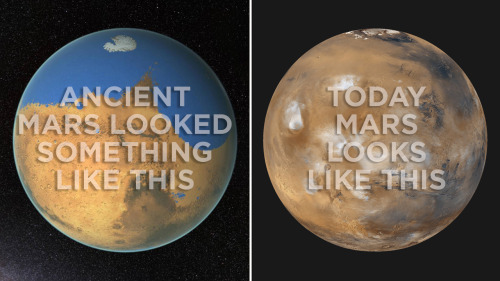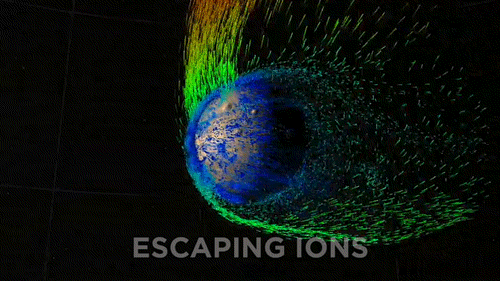On A Fossil-hunting Trip With Her Family, Five-year-old Daisy Morris Found The Remains Of A Previously
On a fossil-hunting trip with her family, five-year-old Daisy Morris found the remains of a previously undiscovered dinosaur, which is now named Vertidraco daisymorrisae. The new dino is not only a previously unknown species, but an unknown genus, making Daisy’s find a really big deal. It’s a pterosaur — a winged flying dino — about the size of a crow, which lived 115 million years ago.
More Posts from Dotmpotter and Others


New Guinea is one of the most linguistically diverse places in the world, with more than 1000 distinct languages crammed into an area not much larger than the state of Texas.
Despite this rich variety—for comparison, Europe contains about 280 languages—linguists have only analyzed the grammatical structures of a fraction of the South Pacific island’s languages. Now, Simon Greenhill, a linguist at Australian National University in Canberra, is trying to remedy that situation, by gathering together hundreds of thousands of words from published surveys, book chapters, and articles, as well as the accounts of early European explorers, and putting them into an online database called TransNewGuinea.org.
Updated daily, the site already contains glossaries for more than 1000 languages from 23 different language families, including 145,000 words. There are roughly 1000 different words for “water,” as well as for “louse,” and linguists and language enthusiasts can view all the languages by geographic origin in an interactive map.
Greenhill introduced the scientific community to the site(PDF) this week in the journal PLOS ONE; already, he has used the database to look for clues about how the different languages are related. Through comparative, historical, and computational analyses of the data, he hopes the linguistic community will now use the site to solve long-standing questions about how New Guinean populations expanded and spread their culture.

Thursday is World Maritime Day which this year spotlights maritime transport as a cost-effective and energy-efficient link in the global supply chain.
Get more information from International Maritime Organization on shipping, sustainable development and the “future we want” here.
No amount of multivitamins, yoga, meditation, sweaty exercise, superfoods or extreme time management, as brilliant as all these things can be, is going to save us from the effects of too much work. This is not something we can adapt to. Not something we need to adjust the rest of our lives around. It is not possible and it’s unethical to pretend otherwise. Like a low-flying plane, the insidious culture of overwork is deafening and the only way we can really feel better is if we can find a way to make it stop.
No, it’s not you: why ‘wellness’ isn’t the answer to overwork (via brutereason)

So, a new plant related to the potato is being named after Mark Watney and this makes me very happy.

“My lab group has decided to name this new species Solanum watneyi after Mark Watney, the book/film character who shows us all that botanists can be cool, too.” - Dr. Chris Martine, Professor at Bucknell University

A good way to remember the human bones in the body. Dope pic
www.learninghumananatomy.com


This terrifying eel-robot will perform maintenance on undersea equipment
Nope.

This is just great.




Ancient Mars had a thick atmosphere filled with carbon dioxide that kept it warm. Rivers trickled into lakes across its surface. Some researchers think there might even have been an ocean. It looked a lot like ancient Earth.
But Mars doesn’t have Earth’s magnetic field, and that has made all the difference. Our magnetic field blocks solar wind - the high energy particles emitted by the sun.
Thanks to new data from the Mars Atmosphere and Volatile Evolution Mission (MAVEN) we know that this solar wind has been assaulting Mars for centuries, and as a result its atmosphere is constantly leaking into space.
Read more here!
NASA Does Hurricanes

When you think of NASA, you probably think of space. Which makes sense, because space is a huge part of what we do. That being said, here at NASA we are also involved in many other research areas, and even play a role in hurricane weather forecasting.
Our satellites, computer modeling, instruments, aircraft and field missions all contribute to a mix of information used by scientists to get a better understanding of these storms. Aspects of storms from rainfall rates to surface wind speed are all analyzed to help identify the potential for storm formation or intensification.

Currently, our satellites are passing overhead as Hurricane Joaquin (above) travels through the Atlantic Ocean. Our Global Precipitation Measurement, or GPM Core satellite captured images and rainfall rates of the storm. GPM showed a large area of very intense rain, which indicates that large amounts of heat are being released into the storm’s center. This fuels the circulation and provides the means for its intensification.
Maximum sustained winds have increased to near 80 mph and additional strengthening is expected. Joaquin could become a major hurricane during the next few days.

In 2016, we’re launching the Cyclone Global Navigation Satellite System (CYGNSS), which is a constellation of eight small satellites. With this launch, we will be able to better understand the rapid intensification of hurricanes, and improve hurricane intensity forecasts.
In addition to our satellite technology, we also conduct field missions to study hurricanes. In our most recent field mission, we investigated the process that underlie hurricane formation and intensity change in the Atlantic Ocean basin.
-
 can-u-smell-that-thats-comedy reblogged this · 1 year ago
can-u-smell-that-thats-comedy reblogged this · 1 year ago -
 saphicspacesociety19 reblogged this · 1 year ago
saphicspacesociety19 reblogged this · 1 year ago -
 19-cilmaengwyn reblogged this · 4 years ago
19-cilmaengwyn reblogged this · 4 years ago -
 19-cilmaengwyn liked this · 4 years ago
19-cilmaengwyn liked this · 4 years ago -
 saturn-itself reblogged this · 4 years ago
saturn-itself reblogged this · 4 years ago -
 onemomentin1995 liked this · 5 years ago
onemomentin1995 liked this · 5 years ago -
 vblaqk reblogged this · 5 years ago
vblaqk reblogged this · 5 years ago -
 mcgeekle liked this · 5 years ago
mcgeekle liked this · 5 years ago -
 kelseybex liked this · 5 years ago
kelseybex liked this · 5 years ago -
 lerayon liked this · 5 years ago
lerayon liked this · 5 years ago -
 reignandco liked this · 5 years ago
reignandco liked this · 5 years ago -
 peacefulboo liked this · 5 years ago
peacefulboo liked this · 5 years ago -
 macaroni-rascal reblogged this · 5 years ago
macaroni-rascal reblogged this · 5 years ago -
 lark1537 liked this · 5 years ago
lark1537 liked this · 5 years ago -
 queerspacecadet reblogged this · 5 years ago
queerspacecadet reblogged this · 5 years ago -
 betterluckwithabeard reblogged this · 6 years ago
betterluckwithabeard reblogged this · 6 years ago -
 betterluckwithabeard liked this · 6 years ago
betterluckwithabeard liked this · 6 years ago -
 ivefoughtyoursister reblogged this · 6 years ago
ivefoughtyoursister reblogged this · 6 years ago -
 ivefoughtyoursister liked this · 6 years ago
ivefoughtyoursister liked this · 6 years ago -
 frill-shark liked this · 6 years ago
frill-shark liked this · 6 years ago -
 ginger-swag-rapunzel reblogged this · 6 years ago
ginger-swag-rapunzel reblogged this · 6 years ago -
 archangel-nosferatu liked this · 6 years ago
archangel-nosferatu liked this · 6 years ago -
 blue-tonsure-and-pronouns reblogged this · 6 years ago
blue-tonsure-and-pronouns reblogged this · 6 years ago -
 blue-tonsure-and-pronouns liked this · 6 years ago
blue-tonsure-and-pronouns liked this · 6 years ago -
 bacon-bap reblogged this · 6 years ago
bacon-bap reblogged this · 6 years ago -
 why-cant-i-be-hot-and-witty liked this · 6 years ago
why-cant-i-be-hot-and-witty liked this · 6 years ago -
 frozenbasalt reblogged this · 6 years ago
frozenbasalt reblogged this · 6 years ago -
 mahoukistuneshojou liked this · 6 years ago
mahoukistuneshojou liked this · 6 years ago -
 benedoodle-fumpernickel liked this · 6 years ago
benedoodle-fumpernickel liked this · 6 years ago -
 the-warmest-night reblogged this · 6 years ago
the-warmest-night reblogged this · 6 years ago -
 daddy-come-home liked this · 6 years ago
daddy-come-home liked this · 6 years ago -
 itsmuscarinethings liked this · 6 years ago
itsmuscarinethings liked this · 6 years ago -
 ladybirdlegs reblogged this · 6 years ago
ladybirdlegs reblogged this · 6 years ago -
 athousandsacredplaces reblogged this · 6 years ago
athousandsacredplaces reblogged this · 6 years ago -
 conflagrationamalgamation liked this · 6 years ago
conflagrationamalgamation liked this · 6 years ago -
 clearjoy reblogged this · 6 years ago
clearjoy reblogged this · 6 years ago -
 missmillyashford liked this · 6 years ago
missmillyashford liked this · 6 years ago -
 sariah102 liked this · 6 years ago
sariah102 liked this · 6 years ago -
 seriouslywhatamievendoing reblogged this · 6 years ago
seriouslywhatamievendoing reblogged this · 6 years ago -
 chibigikochin reblogged this · 6 years ago
chibigikochin reblogged this · 6 years ago -
 chibigikochin liked this · 6 years ago
chibigikochin liked this · 6 years ago -
 okbae reblogged this · 6 years ago
okbae reblogged this · 6 years ago -
 iceh34rt reblogged this · 6 years ago
iceh34rt reblogged this · 6 years ago -
 lilymalonexox liked this · 6 years ago
lilymalonexox liked this · 6 years ago -
 queenanne1532 reblogged this · 6 years ago
queenanne1532 reblogged this · 6 years ago -
 doubleowinchester reblogged this · 6 years ago
doubleowinchester reblogged this · 6 years ago